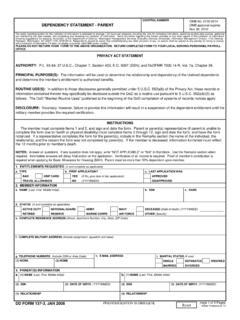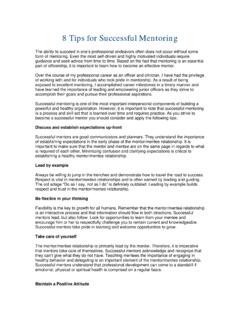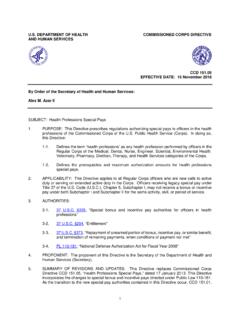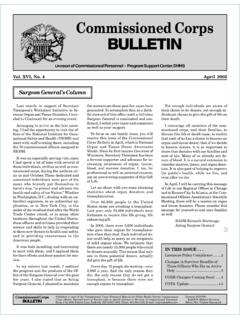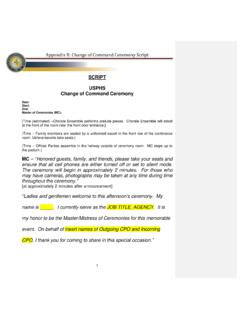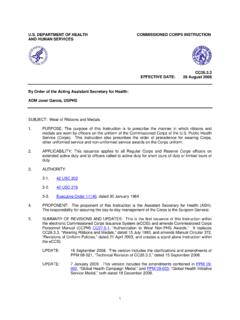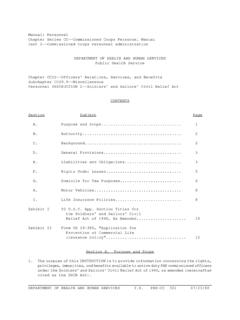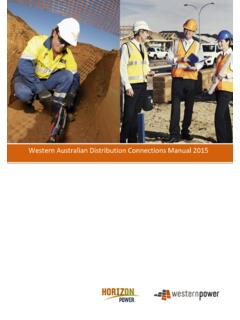Transcription of Writing Better Bullet Statements - PSC
1 CHAPTER 19. Writing Better Bullet Statements CHAPTER 19: Writing Better Bullet Statements This chapter covers: Getting started Drafting Accomplishment-Impact Bullet Statements Polishing Accomplishment-Impact Bullet Statements Bullet Statement Mechanics Bullet Statements are used in many Air Force documents, from the Air Force papers discussed in chapter 16 to the official personnel records of Airmen. While this chapter focuses on Writing Better Bullet Statements for use in personnel records, the principles here can be used to improve any written product wherever Bullet Statements are used. Performance reports/appraisals (officer, enlisted and civilian), awards and decorations are part of everyone's permanent personnel records. These records are used by commanders, managers and supervisors to document an individual's performance over a specific period of time.
2 If you supervise just one person, you play a vital role in his/her career. You provide the opportunities for success and you have the obligation to document employee performance. Through leadership, mentoring and effective Writing , you can ensure the employees you supervise are afforded opportunities for success and increased responsibilities by documenting their success on performance reports/appraisals, awards and decorations. The guidance here is general in nature; you must ensure all performance reports/appraisals, awards and decorations you prepare follow appropriate instructions/regulations and applicable command guidance. Of course, the most important part of documenting performance is getting started. - 247 - The Tongue and Quill AFH 33-337, 27 MAY 2015. Getting Started Get Organized: Keep records of all the accomplishments, awards, and recommendations for all those you supervise.
3 Create a file folder paper, electronic or both for each employee and make regular entries to everyone's folder. This will drive you to keep in touch with your subordinates and involved in their professional development. Know the format : Most evaluation forms are written using Bullet Statements . Use the font and point size specified by the governing instruction or software used to produce the report. Editing: The Tongue and Quill includes a section on The Mechanics of Writing with guidance for grammar, punctuation, abbreviations, capitalization, hyphens and numbers to help you avoid misspelled words, typographical errors and other mistakes that reflect poorly on you and distract officials reading the report. Write Effectively: Get the reader's attention. Positive words and phrases leave a lasting impression with readers.
4 Neutral or negative words and phrases give the impression that the person you are Writing about is average or below average. Drafting Accomplishment-Impact Bullet Statements The heart of effective Writing involves Writing effective accomplishment-impact Statements . If you are like many supervisors, you've likely stared at a blank report and wondered, How in the world do I even start to write effective Bullet Statements ? Whether you are in that situation for the first or 100th time, here are some steps that will help you write effective accomplishment- impact bullets. Step 1: Extract the Facts The first step is the hardest part of Bullet statement Writing getting started! Supervisors often get in trouble early because they do not capture information on their employees regularly or completely. Without a good file of accomplishments for each employee, it is hard to write about what each has accomplished.
5 Gather the Information Begin by getting organized and creating a file for each employee. Collect all of the information you can find that is relevant to each accomplishment and file this information in the file you have created for that employee. Capture everything you can direct information and support that may be remotely related to the accomplishment on paper or electronically. What looks unimportant today may be a key piece of information later. As you gather information and make annotations, consider the following tips for what to look for and how to mark what you find: Isolate the action: Isolate and record the specific action the person performed. Annotate the record: Mark the action with a power verb that best describes the action ( , repaired, installed, designed, etc.). Measure the action: Document related numerical information (number of items fixed, dollars saved, man-hours expended, people served, pages written, etc.)
6 - 248 - CHAPTER 19. Writing Better Bullet Statements Connect the dots: Document how this accomplishment impacted the bigger picture and broader mission of the unit, group, wing, installation, command or Air Force. Ask the member: Facts and figures do not always present themselves easily. Talk to the people you supervise. They are in the best position to clarify information on the tasks they perform, provide details about what they have accomplished, and inform you on how the task was done ( , saving time, treasure or talent). Ask others and check the tech: Ask coworkers and other supervisors who may have seen this person in action. Also, consult Technical Orders, customers served, letters of appreciation, automated work production documents or other sources to get all the information you need. Capture from the start: Track your subordinate's accomplishments as they happen.
7 Keep a record of significant work performance (both good and bad). This habit will help you be prepared when it's time for a performance report, feedback, award ordecoration. Gathering information does not take as much time if it is performed regularly. Be prepared to schedule ample time with your people and make notes on what you need to include (or verify) in an employee's record. If you think gathering information as a routine takes too much time, consider how long it will take to write a good performance report, award or decoration request without the information and how much you will spend tracking it down in the face of deadlines and irate superiors. Without documented information on performance, you are forced to rely upon loose generalizations and vague Statements rather than convincing facts. Sort the Information With the information you have gathered, the next task is to sort the useful items from the items that are not useful.
8 Test each item to see if it is truly associated with the accomplishment you identified earlier or if the item is unrelated to the accomplishment. The test is to ask, Is this bit of information solidly connected to this single accomplishment? If the answer is yes, flag the information as useful. If the answer is no, line through or flag the information as not useful but never throw it away or delete it! Although it may not be useful now, it may be just what you need for another Bullet later. Continue applying this question to all of the items you've collected for this Bullet statement. Once the bits of information are sorted, you will have a stack of information that pertains precisely to the accomplishment and the Bullet statement to be written. Step 2: Build the Bullet 's Structure The next step is to take the sorted information and organize it into an accomplishment-impact Bullet .
9 Group the sorted items for each accomplishment as either the accomplishment (the what). or the impact (who, when, how, why). The Accomplishment Element The accomplishment element begins with an action. Action is best expressed with strong action verbs. The table, below, contains a short list of action verbs that can be used to start Bullet Statements . These are not all the action verbs that can be used, but it should get you started in Writing that next evaluation, appraisal, award or decoration package. - 249 - The Tongue and Quill AFH 33-337, 27 MAY 2015. Action Verbs for the Accomplishment Element Accomplished Achieved Acquired Acted Activated Actuated Adapts Adhered Adjusted Administered Advised Agitated Analyzed Anticipated Applied Appraised Approved Aroused Arranged Articulated Assembled Asserted Assessed Assigned Assisted Assured Attained Attend Authorized Averted Bolstered Brought Build Calculated Capitalized Catalyzed Chaired Challenged Clarified Collaborate Collected Commanded Communicated Compared Compelled Competed Compiled Completed Composed Comprehend Computed Conceived Concentrated Conducted Conformed Confronted Considered Consolidated Consulted Contacted Continued Contracted Contributed Controlled Cooperate Coordinated Created Cultivated Delegated Demonstrated Deterred Developed Devised Displayed Dominated Drove Elicited Embodied Emerged Emulated
10 Encouraged Endeavored Energized Enforced Enhanced Enriched Ensured Escalated Established Exceeded Excelled Expanded Expedited Exploited Explored Fabricated Facilitated Focused Forced Formulated Generated Grasped Helped Honed Identified Ignited Impassioned Implemented Improved Initiated Inspired Insured Invigorated Kindled Launched Maintained Manipulated Motivated Organized Originated Overcame Oversaw Performed Perpetuated Persevered Persuaded Planned Practiced Prepared Produced Projected Promoted Prompted Propagated Propelled Quantified Rallied Recognized Rectified Refined Reformed Regenerated Rehabilitated Rejuvenated Renewed Renovated Reorganized Required Resolved Revived Sacrificed Scrutinized Sought Solved Sparked Spearheaded Stimulated Strengthened Strove Supervised Supported Surpassed Sustained Transformed Utilized - 250 - CHAPTER 19.
